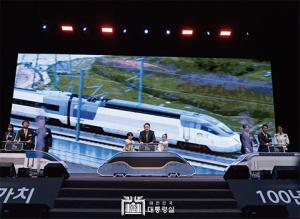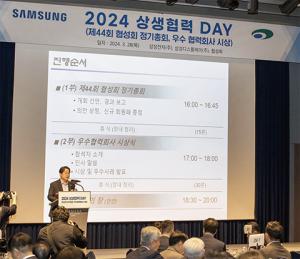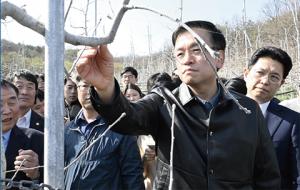 |
||
Utilizing the central government’s good connections to realize Yongin Renaissance and to secure its authority
Yongin City Mayor Lee Sang-il is a well-known politician in major political circles. He worked as a political reporter in well-known media for a long time during which he built strong connections. He stepped into politics at the recommendation of former President Park Geun-hye and served as a member of the 19th National Assembly. During the presidential election in 2022, he served as the head of the Public Affairs Office of Yoon Suk-yeol. He was recognized for his talent recruitment and external cooperation skills. There is no hesitation in his move as much as his strong personal connections. As a ‘collaborative decision maker’, he has a great stride as a ‘big mayor’ leading special cities and large cities.
His collaborative decision maker’s role started with Koki Bridge. This small bridge connects Dongcheon-dong, Yongin and Daejang-dong, Seongnam which is one of the conflicts commonly occur between cities. On July 2, right after his inauguration, Lee met Seongnam Mayor Shin Sang-jin and National Assembly member Ahn Chul-soo. They exchanged opinions on extending the bridge from Koki-dong, Yongin and Daejang-dong, Seongnam and they signed a business agreement in September.
On October 28, Lee attended a meeting with mayors, county heads, and district heads hosted by President Yoon Seok-yeol. He asked Minister of the Interiro and Safety Lee Sang-min, who sat with him at the head table, to expand administrative and financial authority in special cities. He also asked Woo Dong-gi, chairman of the Presidential Committee for Balanced National Development, to appoint a representative ex-officio member who will convey the position of the special city to the local era committee created in accordance with the “Special Act on Local Autonomy and Decentralization and Balanced Regional Development.”
He also met with Lee Jin-bok, the presidential secretary for political affairs, Choi Sang-dae, the second vice minister of the Ministry of Strategy and Finance, and Jang Sang-yoon, the vice minister of the Ministry of Education, to propose infrastructure expansion and school establishment for semiconductor construction. In addition, Minister of Land, Infrastructure and Transport Won Hee-ryong visited Lee’s office to hear suggestions on roads, railroads, and urban innovation.
Now, the heads of the city’s departments look to Mayor Lee when things are not going well with the central government or related organizations. On the request of a department, Lee recently met with second vice minister of Health and Welfare Park Min-soo and demanded that the disadvantages Yongin citizens observe in the process of selecting recipients of basic livelihood security should be carried out fairly. Lee said “Isn’t this the role of the mayor who should be at the place where he needed?”
Mayor Lee put up ‘The future we create together, Yongin Renaissance’ as the municipal slogan. The first approval he made as a mayor was ‘Global Semiconductor Center City Promotion Strategy’. He saw the semiconductor industry as the greatest opportunity for ‘Yongin Prosperity’ and expressed his intention to concentrate his administrative capabilities. ‘Semiconductor’ is the central axis for realizing the Yongin Renaissance.
He picked three things to realize this: Maximization of the ondol effect, construction of semiconductor infrastructure, and overall modernization of the city.
The maximization of the ondol effect refers to the warming effect in the upper neck (the entire city economy) when a fire is lit in the lower neck (semiconductor). In other words, he intends to increase employment and consumption, expand commercial districts, and expand urban functions through the activation of the semiconductor industry.
Mayor Lee builds an L-shaped semiconductor belt to build semiconductor infrastructure in Yongin. The belt embraces Yongin Platform City, Samsung Semiconductor Giheung Campus, Giheung Future High-tech Industrial Complex (Semes), Jigok General Industrial Complex (Lam Research), Tongsam General Industrial Complex (Surplus Global), Yongin Techno Valley, 2nd Yongin Techno Valley, and Wonsam-myeon Yongin Semiconductor cluster. The city will build a 73km semiconductor highway connecting the lower part of the belt, and expand local road No. 57. The city also establishes a semiconductor AI high school and a semiconductor department in the university within the jurisdiction.
Mayor Lee plans to redesign the value of the city as a cutting-edge future city through the overall modernization that includes metaverse, virtual reality, artificial intelligence, and fully autonomous driving that can be implemented in everyday life.
Lee said, “We will focus on achieving qualitative changes in all fields, including transportation, education, culture and arts, agriculture, livestock, and sports for life. Through this, we will not only increase the city’s competitiveness, but also upgrade the standard of citizens’ lives. There is a saying that a dream dreamed alone is just an ideal, but a dream dreamed together becomes a reality. If we gather wisdom with 1.1 million Yongin citizens, we will be able to achieve the Yongin Renaissance.”
 |
100 days as tense as a drama
Resolving the problem of habitual flooding Koki Bridge
The 100 days of Lee Sang-il, mayor of Yongin Special City, were tense like a drama. Among them, the most impressive performance must have been the process of solving the habitual flooding of the 25 meter long Koki Bridge. This area suffered property damage of 3.8 billion won due to the flooding of the Dongmak Stream due from the heavy rain last August. This damage is more than half of the city’s total damage of 5.6 billion won. The flooding of the Dongmak Stream, the flooding of the Koki Bridge, and the flooding of nearby houses and soil caused repeated damages year by year. Myaor Lee moved fast. He removed piles of dirt from inside the flooded houses and worked hard to arrange the furniture. Mayor Lee directly called Minister of the Interior and Safety Lee Sang-min, explained the damage, and requested an on-site visit. Afterwards, this area was designated as a special disaster area, and 50-80% of the flood restoration cost was subsidized by the government. Tax payments for flood victims were suspended and public utility bills were also reduced. Mayor Lee also sent a letter to Lee Byeong-ho, president of the Korea Rural Corporation, requesting the reservoir to be dredged, saying that the neglected sedimentary soil blocks the water that should flow into the Naksaeng Reservoir, causing the Dongmak Stream to overflow and leading to the inundation of the Koki Bridge. At the end of September, Gyeonggi Province Governor Kim Dong-yeon, Seongnam Mayor Shin Sang-jin, and Yongin Mayor Lee Sang-il signed a business agreement at the Gyeonggi Provincial Office. The media reported that such a process was a “miracle of Koki Bridge.”
Yongin as the future Silicon Valley
3 policies for promoting semiconductor in the region
The core element of the science and technology civilization is semiconductor. Semiconductors are the heart of the world and the heart of the Korean economy. One of the reasons why Yongin is the most important city in Korea is because it is the semiconductor hub. Yongin’s semiconductor strategy can be said to be the rudder that determines the country’s future industry. For this reason, Yongin Special City Mayor can be responsible for the vitality of the “heart of the city economy.” Establishing Korea’s Silicon Valley is to properly equip the city’s economic foundation, and it has a knock-on effect that dramatically raises the standard of citizens’ lives. Mayor Lee is using Yongin’s semiconductor belt as the basis for his ‘urban prosperity strategy’.
 |
| ▲ Yongin Special City Mayor Lee Sang-il |
Yongin’s Renaissance comes from semiconductor and humanitarianism
Urban promotion and urban dignity at the same time
Yongin’s Renaissance comes from semiconductor and humanitarianism. Based on this, Mayor Lee plans to improve the quality of life, culture, education, historical value, art, life, and sports in the city. Yongin’s vision of cultural prosperity is by no means an ornamental slogan or an assortment. It is the core vision of Mayor Lee to make Yongin an attractive local government that all cities in Korea envy. The high civic consciousness and caring spirit of Yongin, which was shown through hosting the Gyeonggi-do Sports Festival and the Paralympic Games, received great attention. The answer to the city’s policies always lies with the citizens. Mayor Lee’s idea is that a renaissance befitting the “height of life and culture” that has already matured in the hearts of Yongin residents should occur. Yongin has five great resources. The first is citizen. Numerous civic events such as sharing events, bazaars, festivals, volunteer activities, markets, performances, and walking are the best resources. Space design and urban design for these events are also essential. The second is culture. It is the potential of actively discovering literature, art, play, education, and lectures to raise the level of culture. The city government should actively help cultural artists to systematize and expand their activities. The third is natural resource. Yongin, which is comparable in size to Seoul, boasts beautiful nature and outstanding landscapes. A bold natural city design with the charm of Yongin must be brought up. It is necessary to create a city that is a place where everyone wants to walk and everyone wants to visit. The fourth is spirit. Yongin is rich in historic figures such as Jeong Mong-ju, Jo Gwang-jo, Nam Gye-woo, Nam Gu-man, Jang Uk-jin, Lee Han-eung and many more. Yongin is the hometown of people who practiced noble values such as patriotism, innovation, and art. Each one can become an outstanding theme park. Comprehensive policies are needed to realize these values. The fifth but not least is redesign of cultural resource. Yongin has Natural Farm, Everland, and a folk village, but they have rather limited the image of the city. It is necessary to newly organize places, spaces and facilities that are future-high-tech-dream-oriented and can become a symbol of the city. It is necessary to renew the city branding centered on bold and special ‘cultural resources’. Innovative driving force is needed to make ‘Yongin Renaissance’ the contents of the city government by utilizing 5 resources. Mayor Lee’s vision, the future of Yongin, has never existed before which are leading to practice (miracle of Koki Bridge), unfold (semiconductor prosperity), and soar (cultural prosperity). We are standing in the front of that vision.
백종원 기자 bridgekorea@naver.com







